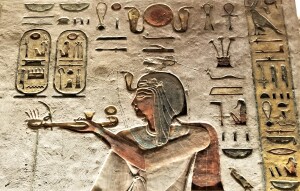King Ramesses III
Probably not as well known as Ramesses II, Ramesses III ruled Egypt for 31 years from 1186 to 1155BC. His rule was during a very turbulent time in Egypt. There were many wars, invasions, decline in the economy, poor crops, and the first ever recorded labor strike. But he weathered most of these conditions and did implement a few programs to enrich Egyptian life, like his tree planting program. (WOW!)
As for the wars, during his rein there were incursions by those they called the “Sea Peoples” from Eastern Mediterranean countries. Ramesses was successful in defeating these intruders but the cost drove economic decline for food and other goods. Food production was already at a decline due to adverse weather conditions that reduced crop production significantly. The production was so impacted by the weather conditions and the wars, that Ramesses was unable to requisition sufficient supplies to feed his laborers working on his temple. This resulted in the first ever recorded “labor strike”.
Ramesses III died in the 32nd year of his rein by a conspiracy brought forward by his secondary wife, Tiye. Apparently, she was not pleased with Ramesses choice to place his eldest son, Ramesses Amenherkhepshef (later known as Ramesses IV) as successor to the throne. One thing led to another and she and 37 others decided to kill the king. And kill the king they did. They slit his throat so deep, the knife rested on his spine, no doubt a fatal attack. But, once the ancient PD got involved all conspirators were found, tried and executed.
The cause of Ramesses III’s death was unknown until it was revealed by CT scan in 2011 of his mummy showing a massive cut at the throat.
Like the other tombs here in Valley of the Kings, Ramesses III is decorated from entry to burial chamber, wall to ceiling, with hieroglyphics depicting the Gods welcoming the King and the King being depicted as the savior of Egypt. Every carving, painting, and inscription was made to serve a purpose, the king entering the after-life.
Something you should know about these depictions and carvings. Early Egyptian tombs did not have as many depictions of food, water, helpers, or animals. Instead, these early tombs had depictions focused on God’s accepting the dead into the after-life and scenes of good things the deceased had performed during their life. The reason for the difference is at that time there were priests and servants assigned to each tomb to bring food, water, flowers, etc. into the tomb every day. It was believed that the Gods would need the nourishment and support goods to help transition the deceased to the after-life, so every day they brought fresh goods to the tomb.

Ramesses III offering incense to the Gods. Note the two cartuches, one for royalty, one for his born family
Somewhere along the line, the priests decided that instead of bringing food and goods to the tomb every day, they could just depict these items on the walls and once the Gods arrived to take the deceased to the after-life, these depictions would come to life and could be used by the deceased. I think they just got lazy.
Tomorrow, The Tut




